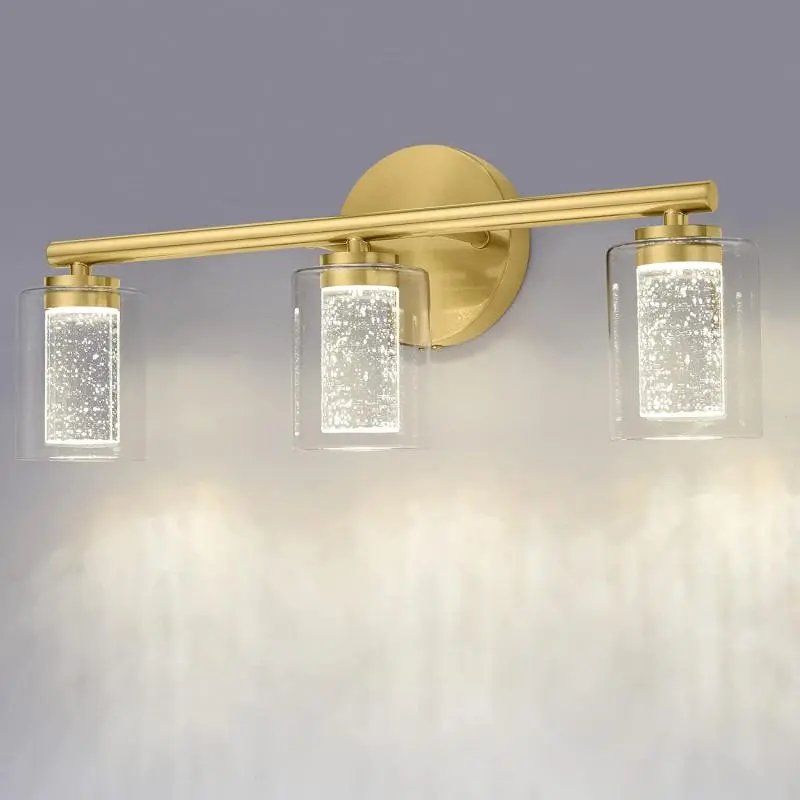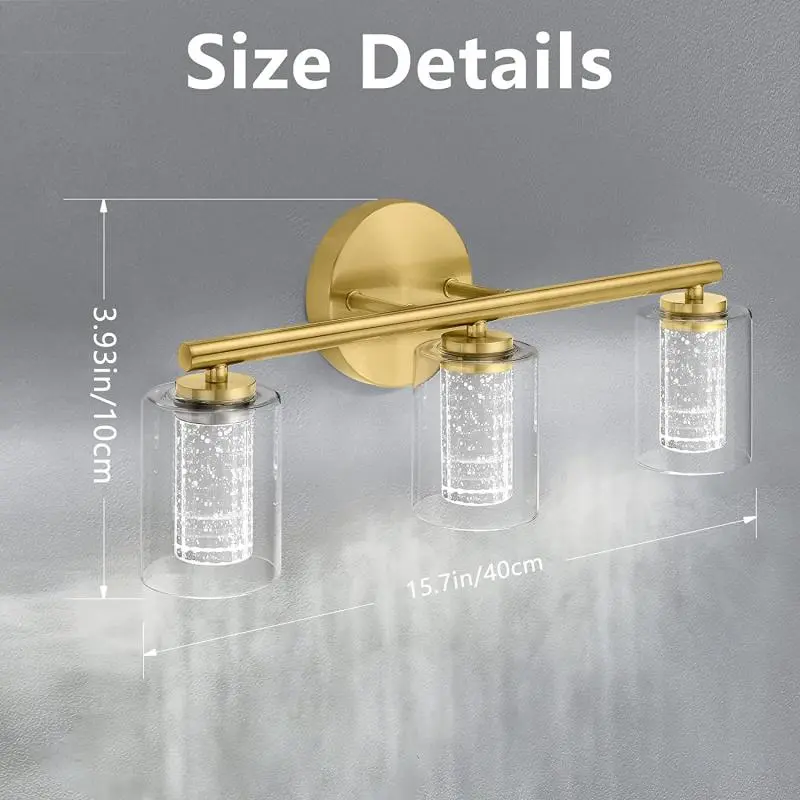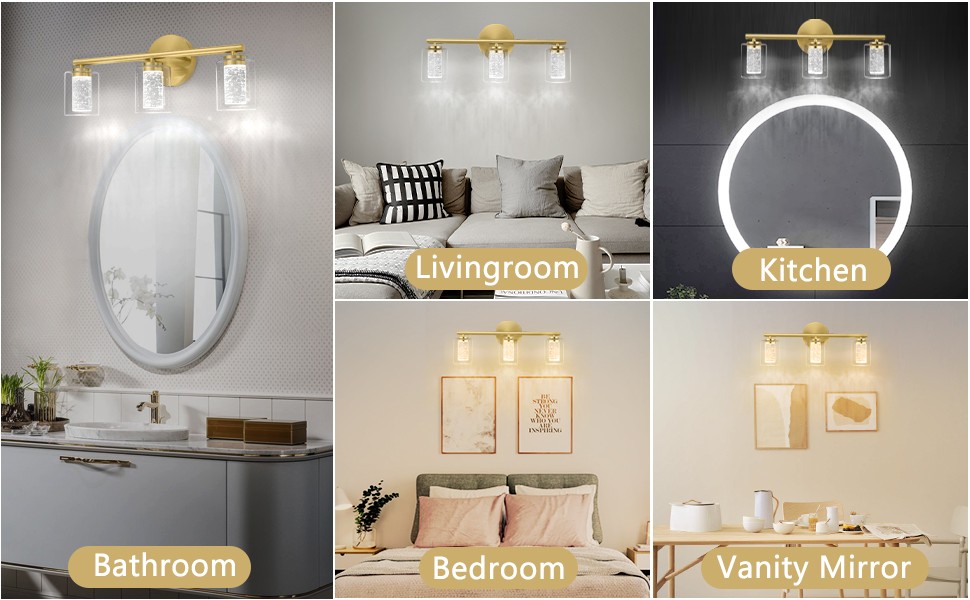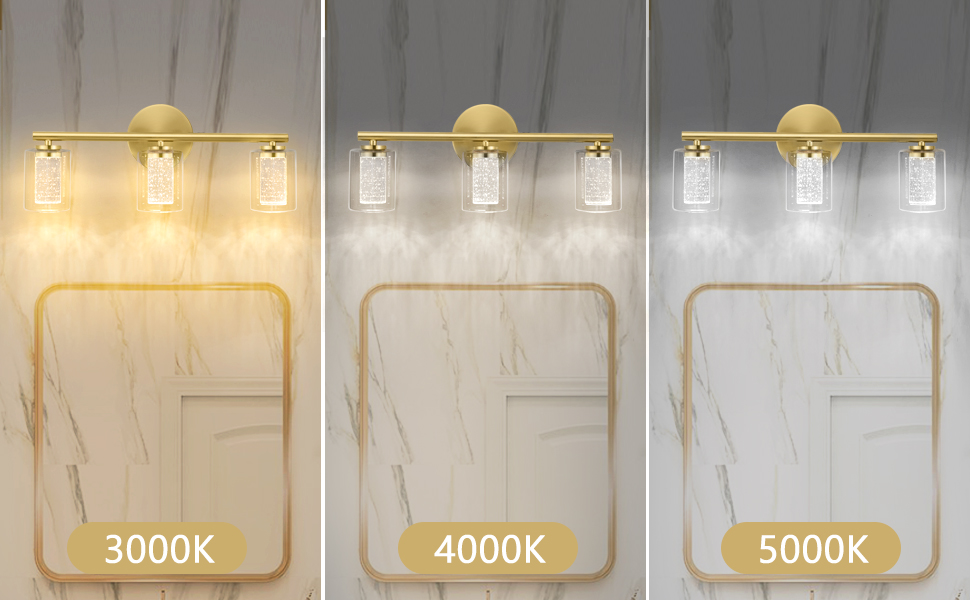Are 3000K-5000K bathroom vanity lights considered warm or cool?
In modern home design, the bathroom is not only a place for bathing but also a crucial space for applying makeup, skincare, and grooming. Given these functional requirements, the choice of bathroom vanity lights is crucial. The optimal light color directly impacts the accuracy of facial makeup application, the ease of skincare application, and the user experience.
Recently, many consumers have been asking: Are 3000K-5000K bathroom vanity lights considered warm or cool? This article will provide a professional analysis of this question, delving into multiple perspectives, including color temperature, light color classification, optical principles, the functional applications of bathroom vanity lights, and the rationale for selecting them.

Color Temperature and Light Color: What You Need to Know
Color temperature (CCT) is a key parameter that measures the coolness or warmth of a light source's color. It's measured in Kelvin (K). Color temperature originates from the concept of blackbody radiation in physics: when a blackbody is heated, it emits light of different colors, with the color shifting with temperature. A low-temperature blackbody emits reddish-orange light, while a high-temperature blackbody emits bluish-white light. Applying this theory to lighting, we develop a relationship between color temperature and light color.
In home and public space lighting, color temperature primarily influences the visual and emotional experience of a space. The lower the color temperature, the more reddish-yellow the light color, creating a warm and comfortable feeling. The higher the color temperature, the cooler the light color, creating a clear, bright, and even invigorating feeling.
Specific classifications are as follows:
• Low color temperature light sources (2700K - 3500K): These light colors tend to be reddish-yellow and warm. They are often used in resting spaces like bedrooms and living rooms to create a warm atmosphere.
• Neutral color temperature light sources (3500K - 4500K): These light colors fall between warm white and white, known as natural white or neutral light. They are suitable for areas where natural skin tones are desired.
• High color temperature light sources (4500K - 6500K): These light colors tend to be bluish-white and cool. Commonly used in spaces requiring high visibility and clarity, such as offices, workspaces, and bathrooms.
Thus, from an optical perspective, a 3000K light source is considered warm, while a 5000K light source is considered cool. The intermediate range of 3500K to 4500K is considered neutral white or natural light. Understanding the relationship between color temperature and light color is the first step in selecting bathroom vanity lights and is crucial for ensuring accurate facial makeup and meticulous skincare application.

3000K-5000K Bathroom Vanity Lights: Warm or Cool?
The color temperature of a bathroom vanity light directly impacts the user's perception of facial skin tone and the fidelity of makeup application. The color temperature range of 3000K-5000K is relatively wide, and its light color is defined as follows:
1. 3000K Bathroom Vanity Light
3000K falls within the warm light range, with a yellowish tint. Warm light creates a soft, comfortable environment, creating a warm and natural bathroom ambiance. It also makes facial skin tones appear softer and more saturated. This type of light source is ideal for creating a warm bathroom atmosphere and is also suitable for use in the morning or evening, reducing light stress on the eyes. However, its limited color rendering can easily cause color casts when applying makeup, especially affecting the true rendering of lipstick, blush, and eyeshadow.
2. 4000K Bathroom Vanity Light
4000K is close to neutral white light, falling between warm and cool tones. This light source maintains a certain warmth while providing clear illumination, making facial skin tones more realistic. For daily skincare, basic makeup, and shaving, a 4000K bathroom vanity light offers a balance of visual comfort and color accuracy, making it one of the best choices for home bathrooms.
3. 5000K Bathroom Vanity Light
5000K is cooler, representing cool white light or a close approximation to natural daylight. This type of light source provides bright, clear light, enhancing facial contours and detail, making it ideal for delicate makeup applications and shaving. A 5000K bathroom vanity light maximizes color reproduction, providing highly accurate lighting conditions for observing skin tones, makeup colors, and fine details. However, it can appear slightly cold, and prolonged use may cause strain.
In summary, a 3000K bathroom vanity light is considered warm, 5000K is considered cool, and 3500K-4500K is considered neutral. Therefore, it's crucial to choose a bathroom vanity light that suits your usage habits and bathroom lighting environment.

Bathroom Vanity: How Does Light Color Affect Makeup and Skincare?
Light color not only influences the ambiance of a space but also directly impacts the effectiveness of makeup and skincare. Facial makeup is sensitive to light, and bathroom vanity lights with different color temperatures can produce different visual effects:
1. The Impact of Warm Light (3000K) Bathroom Vanity Lights
• Advantages: Soft light creates a natural, plump appearance for skin tones, minimizing blemishes; ideal for morning or evening use to avoid glare.
• Disadvantages: Low color reproduction, which can easily lead to color shifts when applying makeup, especially when choosing lipstick, blush, and eyeshadow.
2. The Impact of Neutral Light (3500K - 4500K) Bathroom Vanity Lights
• Advantages: Authentic color reproduction, even facial lighting and shadows, and precise makeup and skincare application; it presents realistic skin tones without creating a strong, cold effect.
• Disadvantages: Harsh light, which can slightly highlight certain details; a light diffusion design is needed to optimize the user experience.
3. The Impact of Cool White Light (5000K) Bathroom Vanity Lights
• Advantages: Bright, clear light, highlighting facial contours and details, allowing for precise makeup application. • Disadvantages: The light color tends to be cool, which can be visually jarring. Long-term use can reduce the warmth of the space.
In addition, the combination of light color and the color rendering index (CRI) determines how accurately bathroom vanity lights portray facial skin tones. Lamps with a high color rendering index (CRI>80) ensure accurate makeup colors, while low CRI values can cause makeup to appear off-color.
Bathroom vanity lights: What are the key points in optical design?
A sound optical design can maximize the benefits of 3000K-5000K light sources and improve the efficiency of bathroom vanity lights. Key considerations include:
1. Light uniformity
The light source should be evenly distributed to avoid areas of excessive brightness or darkness. Symmetrical mounting of lights on both sides of the mirror or combined lighting above and below the mirror can maximize uniform lighting, reduce facial shadows, and enable more precise makeup application.
2. Anti-glare design
Bathroom vanity lights can use diffusers, diffusers, or specialized lamp body structures to prevent direct light from irritating the eyes and improve visual comfort.
3. Color Rendering Index (CRI)
A high color rendering index (CRI) ensures a faithful rendering of skin tones and makeup colors. Professional bathroom vanity lights recommend a light source with a CRI > 80, with some high-end products boasting CRIs exceeding 90, ensuring accurate rendering of facial colors.
4. Waterproof and Moisture-Resistant Design
Bathrooms are high-humidity environments, so bathroom vanity lights should have an IP44 or higher waterproof rating to ensure safety and reliability. The lamp body material should be moisture- and mildew-resistant, and the internal circuitry should be sealed to prevent moisture intrusion.
5. Light Color Adjustment Design
Adjustable dimming and color temperature functions meet the needs of various lighting environments. Choose a gentle warm light for a soothing wake-up in the morning, and switch to neutral or cool white light for makeup application, ensuring both eye protection and accurate color reproduction.

How to Choose a Bathroom Vanity Light Color Temperature? - Scientific Advice
Choosing the right color temperature for your bathroom vanity light is crucial for different usage needs:
• For daily skincare and light makeup: A neutral light between 3500K and 4000K is recommended for both comfort and skin tone reproduction.
• For those applying detailed makeup and shaving: 4500K-5000K cool white light is recommended, providing bright light and sharp details.
• For a cozy bathroom atmosphere: 3000K warm light is recommended for a soft and comfortable glow, but care should be taken to adjust the color of makeup.
At the same time, bathroom vanity lights should be integrated with the overall bathroom lighting environment and coordinated with the ceiling lights and auxiliary light sources to create a balanced lighting environment, avoiding areas of excessive brightness or light color conflicts.
The Role of Bathroom Vanity Lights in the Spatial Lighting Environment
Bathroom vanity lights not only illuminate the face but also influence the overall perception of the space:
• Enhancing Spatial Layering: Appropriate lighting layout can enhance the sense of spatial layering in the bathroom, avoid a monotonous lighting environment, and make the space appear spacious and bright.
• Auxiliary Ceiling Lighting: Ceiling lights provide overall illumination, while bathroom vanity lights provide localized accent lighting. The synergistic light sources enhance visual comfort.
• Light Color Harmony: Bathroom vanity lights with the same or coordinated color temperature as the ceiling lights can avoid light color conflicts in the space and enhance visual comfort.
What product categories does Huari Lighting specialize in?
Huari Lighting offers a broad range of LED products including motion sensor night lights, multifunctional night lamps, silicone night lights, vanity wall lamps, LED downlights, track lights, panel lamps, and cabinet lights. Buyers can purchase these products wholesale at factory-direct prices or customize them for their brands.
Our ISO-certified factory ensures consistent quality. Bulk purchasing, seasonal promotions, and fast delivery make Huari a preferred LED supplier in China.
